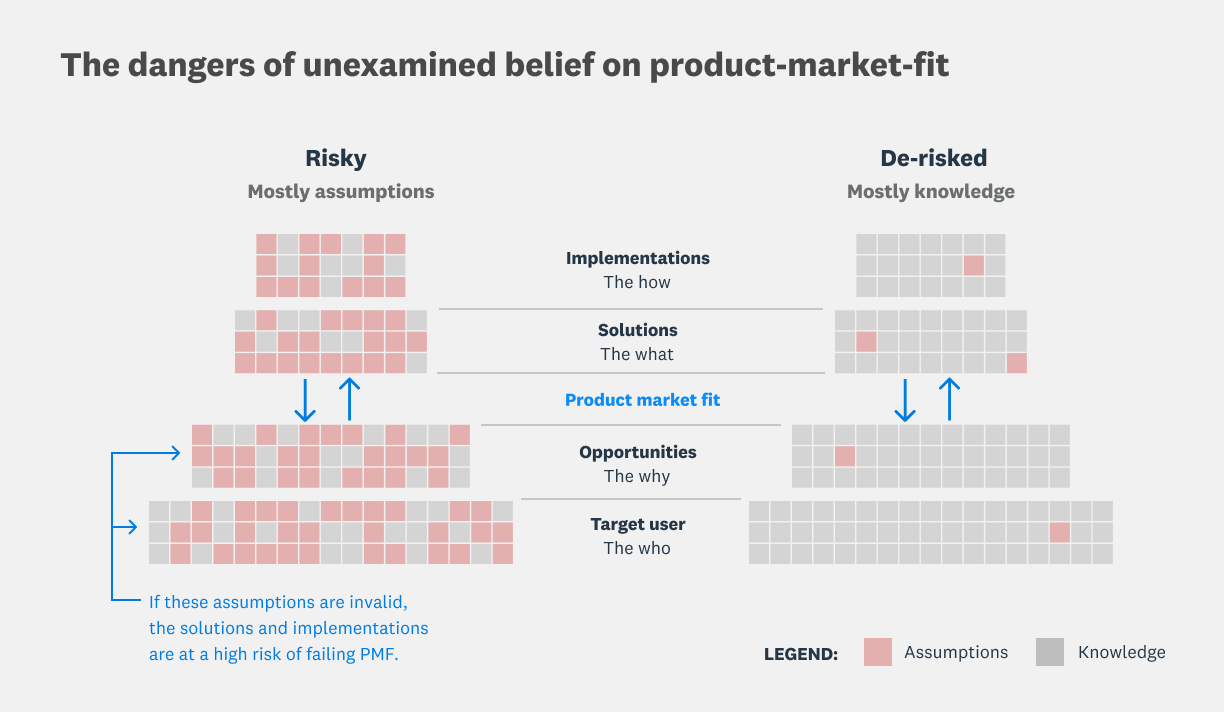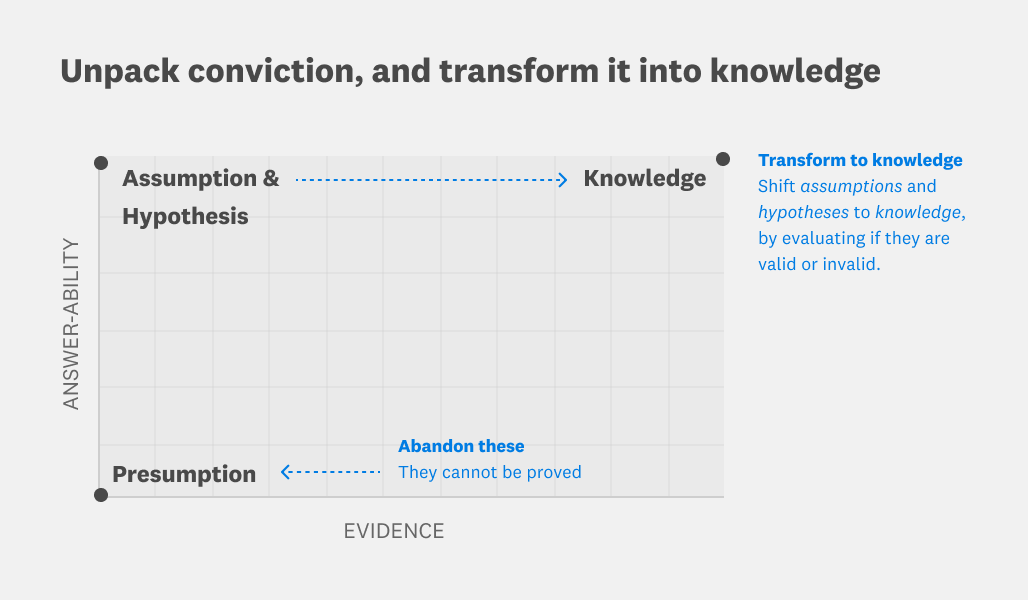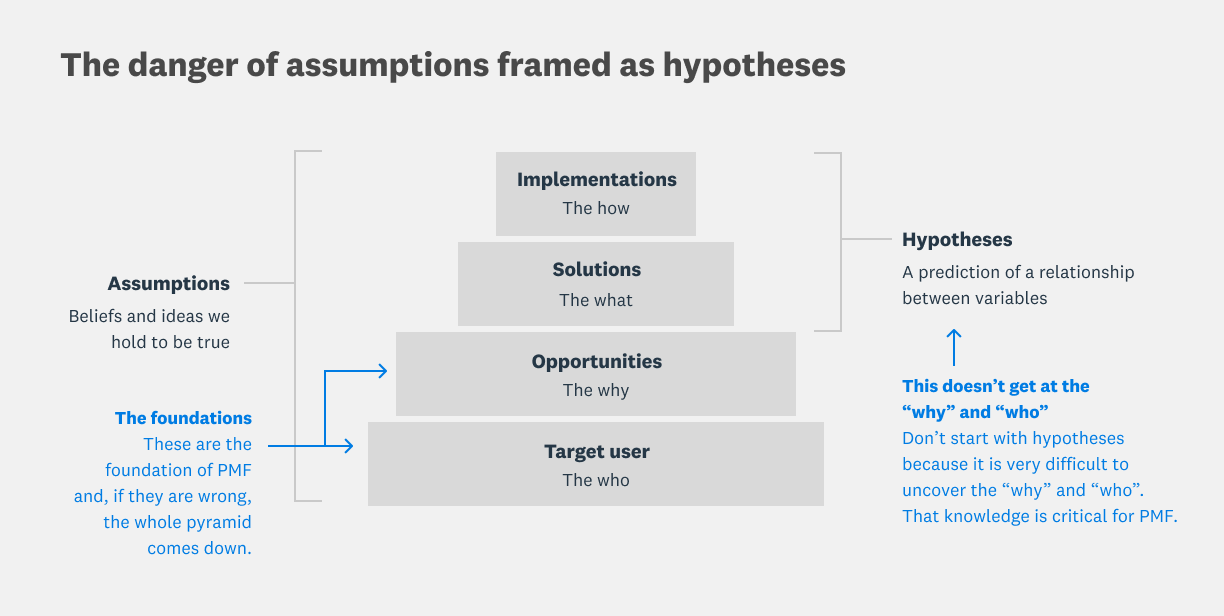Build better products. Start by unearthing and examining assumptions.
 Barb Natali-Sherman
5 min read
Barb Natali-Sherman
5 min read
Why do teams repeatedly build products users don’t need or want? Why do 90% of startups fail? Barb Natali-Sherman, a Director of Design at DesignMap, and Maya Elise Joseph-Goteiner, the former Head of UX for Google Area 120, have cumulatively partnered with 94+ startups in a large FAANG incubator. They are confident there’s a better way to de-risk product development, one that promises more velocity, less resources and better outcomes.
This article was co-authored by Maya Elise Joseph-Goteiner. It is part one of a series on adapting the build, measure, learn cycle to increase early-stage startup success.
Like the lean movement, we think one of the keys to better products is identifying and interrogating assumptions, but rather than validate through building, the maximal moment is pre-code. In this article, we advocate to focus on assumptions and desirability if you want to define and build superior products. We call this process Assumption Led Definition (ALD), and it is highly effective in expediting and de-risking the journey toward product market fit.
THE INGREDIENTS OF BELIEVING
Early-stage startups require conviction. From cumulatively working with 94+ startups, we’ve found believing in a product concept is inspired by a cocktail of knowledge, assumption, and presumption. It’s rare to untangle and tune these individual ingredients when optimizing for velocity. More often than not, knowledge, assumption, and presumption become an unspoken part of the product narrative that—with each sharing— becomes more “real”.
One of the biggest pitfalls we see? Accepting the assumption part of this trio as static. While it can be a massive barrier to success for startups in particular, this oversight can happen to teams of all sizes and maturity. Powerful anchors, assumptions are the building blocks that inform a founder and their team’s perception of viability, feasibility, and desirability.
Rather than take them for granted, our UX team has learned to lean heavily into assumptions to quickly de-risk startup concepts, evolve design mocks, and inform the product direction. Such investments aren’t one-dimensionally UX work. They are critical first steps to close the Product Market Fit (PMF) gap to assess desirability.

ASSUMPTIONS = THE LAUNCHING PAD
We’re not the first to broadcast the importance of assumptions. Validating assumptions is a key tenet of Eric Ries’ The Lean Startup. He defines assumptions as “unproven beliefs you have about why your plan will work.” While there are plenty of great insights in Ries’ philosophy, his directive—to implement the Engineering-led sequence “Build, Measure, Learn”—is costly. It doesn’t optimize for the true power of an assumption (and UX): to lead the iterative process and incrementally move towards PMF.
Contrary to Ries, we suggest a sustained investigation of assumptions as the bedrock of our practice, which we refer to as ‘Assumption Led Definition.’ Ignored, an assumption becomes a relic of the pitch or story and can drive confirmation bias. This limits discovery, possibility, and value creation.
DON’T LOSE YOUR CONVICTION, UNPACK IT
From pitch to funding, beliefs are cemented and can be conflated with facts. Ask a founder “what are your assumptions”? They may have had a few in the early days, but once founders jump into build mode, assumptions tend to be expressed as knowledge.
Before we dive in further, let’s define the ingredients of belief:
- Assumption: An assumption is an effort to connect and increase certainty. It’s a supposition made without evidence often informed by intuition, past experience, mental models, or norms. It requires research to understand if it’s valid or not.
- Presumption: A supposition that cannot be proved. In product development,these are best abandoned.
- Hypothesis: A statement that predicts a relationship between two variables which can be tested through collecting data in an experiment or live product experience.
- Knowledge: Awareness or understanding of a subject or situation that is gained through experience, education, or research.

Founders can also fall into the trap of repositioning assumptions as hypotheses. The appeal of a hypothesis is that it masks uncertainty and, in theory, can be tested. The danger of a premature hypothesis is that it commits the team to code and a solution based on unevaluated assumptions, meaning that potentially multiple phases of problem definition and discovery were skipped. When testing a hypothesis the stakes are higher because you’re dependent on product interaction or usage (from a user you often know little about), and rarely can uncover the “why” of desirability.

The goal in de-risking an assumption is to transform it into knowledge. We’re Assumption Queens, here to reinstate their reputation. We hope you’ll soon see their innate power through the seven steps of Assumption Led Definition:
- Step 1: Unpack and align. Start with a team-wide generative exercise. Map out knowns and unknowns. Unknowns often fall into three buckets: assumptions, presumptions, and hypotheses. A bit of structure can go a long way, categories we regularly prompt include: problem, market, need, value, experience, technology, business. Make sure to double-click into the assumptions, presumptions, and hypotheses. Often teams don’t have unified definitions, commonly referring to assumptions as hypotheses. As a result, ensure hypotheses are unpacked into the assumptions they’re based upon.

- Step 2: Bucket the assumptions. Once you’ve labeled everything in the map, pull out the assumptions from the presumptions, hypotheses, and knowledge. Organize the assumptions into the categories of desirability, viability, and feasibility. Pressure test the assumptions generated against business goals, OKRs, and functional roadmaps to make sure you’ve been as comprehensive as possible.
- Step 3: Prioritize by criticality. Now consider the criticality of each assumption. We typically ask: how severe is this threat to our success? It’s not always easy to answer this question when success is 0-1; expect some healthy debate.
- Step 4: Focus on desirability. PMF is all about desirability. Assumptions that threaten desirability should be your first priority (P0s) because, if they aren’t evaluated early, they could derail the entire business. It’s not worth building a product or figuring out its impact on the business, if ultimately no one wants it. The good news about desirability focused assumptions? They can be assessed without building anything.


- Step 5: Evaluate market assumptions. You can evaluate desirability-focused assumptions through a myriad of methods. We’ve used diary studies, surveys, and in-depth interviews. What’s imperative is how you pursue the evaluation. For example, if you assume the product’s value proposition will resonate with a specific user, you first need to evaluate the pain or challenge as a baseline before you assess the potential benefit of the value propositions. It doesn’t need to be a multi-week investment, we’ve run research in five working days.
- Step 6: Refine the product. With your fresh learnings, go back to the drawing board. Does your target user have an explicit or latent need? Is your value proposition significant for the target user (i.e. if there a real pain or challenge you address)? Do you need to iterate on your storyboard or the concept? Does your MVP prioritize a compelling promise?
- Step 7: Repeat. Assumption Led Definition is a cyclical exercise. We recommend keeping a live tracker of assumptions to maintain movement. Adding a projection of potential learnings such as If we learn …. Then… helps keep an indecisive team accountable.
STOP FAILING, ENGAGE YOUR ASSUMPTIONS
If you walk away with one takeaway, we hope you befriend your assumptions. Don’t fear being wrong, instead, realize the power of your assumption. ALD is a launching pad that could save you from wasting valuable resources.
90% of startups shouldn’t fail. Let’s stop shooting darts in the dark and throwing stuff at walls to see what sticks. Instead, adapt the go-to model of build-measure-learn.
The assumptions supporting your conviction are a good place to start. Create space for your product team to unearth and distinguish what is known vs. unknown. Start with learning. Pause before you invest in building and consider a more efficient approach to product development. Hire UXers who specialize in early-stage startups (we know a few) to demystify desirability.
Designers and Researchers are the partners you need to take a faster iterative approach (learn-prototype-learn-build-measure), with customers, with consumers, with prospects. They are the key to velocity. They will close the PMF gap.
This article originally appeared in Nimble UX by Maya Elise.

